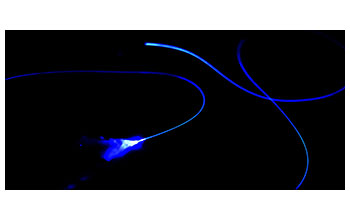Multimedia Gallery
Optical fiber used in resetting mouse circadian clock
Optical fiber used in resetting mouse circadian clock.
More about this image
A team of Vanderbilt University biologists has found a way to use a laser and an optical fiber to reset an animal's master biological clock.
Douglas McMahon, a Stevenson Professor of Biological Sciences at Vanderbilt who directed the study, says "we found we can change an animal’s sleep/wake rhythms by artificially stimulating the neurons in the master biological clock, which is located in an area of the brain called the suprachiasmatic nucleus (SCN), with a laser and an optical fiber."
Mice were used for the study because -- with the exception of their nocturnal lifestyle -- researchers have found that mice possess a biological clock nearly identical to that of humans.
The researchers used a new technique called optogenetics to manipulate the firing rate of the SCN neurons. The technique inserts genes that express optically sensitive proteins into target cells in order to make the cells respond to light.
For the project, the researchers genetically engineered two strains of mice. In one strain, the neurons in the brain contained an optically sensitive protein that triggers neuronal activity when exposed to light. In the other strain, the neurons in the brain had a similar protein that suppressed neuronal activity when exposed to light.
Doctoral student Michael Tackenberg, who worked on the project, is currently testing whether strains of mice that suffer from seasonal affective disorder respond to the new approach.
The discovery could, in principle, be used therapeutically to treat conditions like seasonal affect disorder, reduce the adverse health effects of night shift work and possibly even cure jet lag.
The study was funded in part by a grant from the National Science Foundation's (NSF) Graduate Research Fellowship Program (grant DGE 09-09667).
To learn more about this research, see the NSF News From the Field story New 'reset' button discovered for circadian clock. (Date image taken: January 2015; date originally posted to NSF Multimedia Gallery: March 7, 2016)
Credit: Steve Green
Images and other media in the National Science Foundation Multimedia Gallery are available for use in print and electronic material by NSF employees, members of the media, university staff, teachers and the general public. All media in the gallery are intended for personal, educational and nonprofit/non-commercial use only.
Images credited to the National Science Foundation, a federal agency, are in the public domain. The images were created by employees of the United States Government as part of their official duties or prepared by contractors as "works for hire" for NSF. You may freely use NSF-credited images and, at your discretion, credit NSF with a "Courtesy: National Science Foundation" notation.
Additional information about general usage can be found in Conditions.
Also Available:
Download the high-resolution JPG version of the image. (623.2 KB)
Use your mouse to right-click (Mac users may need to Ctrl-click) the link above and choose the option that will save the file or target to your computer.

